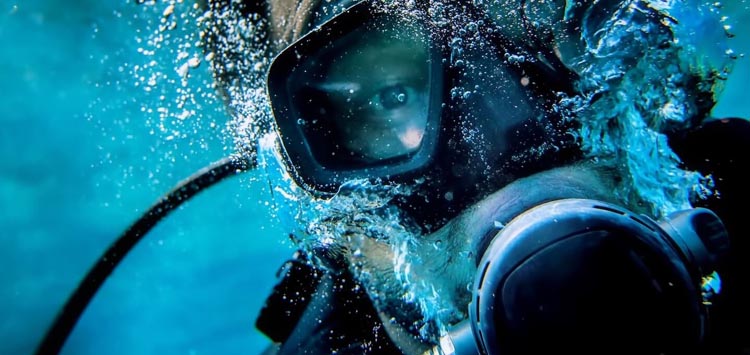The scuba regulator or dive regulator is the most important piece of scuba diving gear. This is what keeps you breathing underwater so what is more important than that?
Understanding how a scuba regulator works gives you better insight on how to dive safely and what to look for when you are purchasing your own scuba breathing apparatus and dive gear. Read on to learn the mechanics of the breathing regulator, an essential piece of diving gear.
If you have just invested in your new scuba regulator, you might want to look at how to assemble your regulator and also tips on cleaning your dive regulator too.
Table of Contents
The 5 Main Parts of a Scuba Dive Regulator
There are five basic elements in a scuba regulator: the first stage, second stage, alternate second stage, gauge console, and the low-pressure inflator hose. Each of these parts is described below, also with the help of this scuba regulator diagram.

1. Scuba First Stage
This is the connection to the pressure tank. As air comes out of the pressurized air tank, the first stage changes this high-pressure air into intermediate pressure air.
From there, the air travels on as intermediate pressure air into the low-pressure hoses.
2. (Primary) Scuba Second Stage
There are two parts that can function as the second stage but, what is usually referred to as the second stage, is actually the primary second stage. The primary second stage is the part connected to the mouthpiece.

The primary second stage takes the intermediate pressure air flowing through the hose and transforms it into ambient pressure air that is safe for the diver to breathe in.
Ambient pressure air means that it has the same air pressure as the water pressure surrounding the diver at that point in the water.
3. Gauge Console
The gauge console is also called the submersible pressure gauge or SPG. The latter describes exactly what it does. The SPG measures how much pressure is still left in the pressurized air tank. On more advanced units the gauge console can also have other monitors on it like a dive computer or depth gauge.
4. Low-Pressure Inflator Hose
The low-pressure inflator hose is the connection between the first stage and the buoyancy compensator or BC. This is the part that lets the diver add air to the BC.
5. Alternate Second Stage
 This is an additional part to the scuba breathing regulator that is actually meant for a second diver. So, if the dive went smoothly, there is no need to use this part.
This is an additional part to the scuba breathing regulator that is actually meant for a second diver. So, if the dive went smoothly, there is no need to use this part.
This has an extra mouthpiece and a longer low-pressure hose so that another diver is able to share with the primary diver. This is only to be used during emergencies when another diver is not able to use their own scuba breathing apparatus anymore.
There are other secondary parts like the mouthpieces, valves and purge buttons but these five parts are the main components. To understand the mechanics knowing what these five parts do is enough basic knowledge.
How Does a Scuba Regulator Work?
Now that you have a basic understanding of the main parts, you can understand how the air flows through it and lets you breathe normally underwater.
As your regulator is a vital piece of diving equipment, it is a good idea to know how it works. If you are looking into investing in your own, you might also want to learn how to assemble it and how to clean a regulator to make sure it stays in good shape ready for your many dives to come.

The water pressure changes as you move to different depths during your dive. This means that the flow also changes. Humans can only breathe comfortably within a certain range of pressure. It is the job of the regulator to ensure that the diver can breathe comfortably from the pressurized tank, no matter at what depth the dive is.
Every time you inhale through the mouthpiece, air from the tank is released into the regulator. The first phase it passes through is the first stage, then through the low-pressure hose to the primary second stage where you are breathing through the mouthpiece.
The low-pressure hose connects to the primary second stage. In the primary second stage, the intermediate pressure air is again changed but this time into the same pressure as the water pressure surrounding the diver, or into ambient pressure air that is safe to breathe in.
So there you have it, hopefully, we have shed some light on the question of How do scuba regulators work? and you can get back to diving. Now you know a little more about this piece of tech why not practice your scuba breathing to get the most out of your bottom time.


